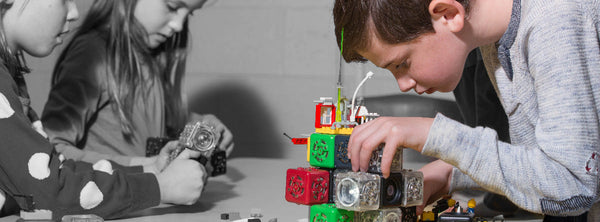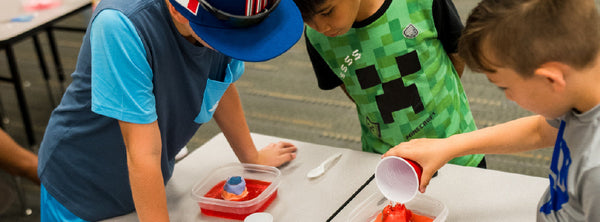
From Fidgety to Fascinated
Why STEM is the Key to Engaging Reluctant Learners

Imagine a space where restless energy is channeled into eager curiosity — where the fidgety child transforms into a captivated learner. Meet Jamie, a fifth grader who could never sit still. Always tapping a pencil or shifting in his seat, direct instruction with paper and pencil activities failed to capture his interest, leaving him disengaged and restless. But everything changed when his teacher introduced a hands-on STE(A)M (science, technology, engineering, (arts) and math) curriculum.
Why Reluctant Learners Struggle
A reluctant learner lacks enthusiasm and motivation to actively participate, often due to a lack of connection to the material or low academic self-confidence. Common reasons for disinterest in traditional learning environments include:
- Relevance: Traditional subjects often feel disconnected from learners' lives and interests.
- Monotony: Repetitive tasks and rote learning fail to capture and maintain learners' attention.
- Lack of flexible, learner-driven projects: Without the opportunity to pursue their passions, learners can feel stifled.
- Lack of active learning: Traditional learning spaces often lack experiential and interactive learning, which is crucial for engagement.
The reluctant learner is often perceived as needing more structured practice, leaving them to miss out on the hands-on experiences and real-world applications that make learning meaningful and exciting.
How STEM Captivates Learners
STEM education naturally engages learners through its hands-on, problem-solving and interdisciplinary approach. The inherent appeal of STEM lies in its ability to transform abstract concepts into tangible, real-world applications.
- Hands-on activities: Building robots, designing bridges and creating experiments captivate learners by allowing them to manipulate materials and see the immediate results of their efforts.
- Problem-solving focus: STEM challenges learners to think critically and devise solutions to complex problems, fostering a sense of accomplishment and competence.
- Interdisciplinary approach: Integrating science, technology, engineering and math helps learners make connections across different subjects, deepening their understanding and keeping their interest alive.
Best Practices to Increase Learner Engagement
Relevance:

Incorporate programs that bring real-world learning to learners. For example, in PCS Edventures’ Build a Better World, learners collaborate on structural challenges as they model earthquake stability, hurricane winds and system integrity to understand how buildings are designed to resist outside forces.
Choice:
Offer a wide variety of options to pique the interest of almost any learner. PCS Edventures offers a wide variety of programming. For example, learners can dive deep into Oceanic Exploration or get ready for take-off in Flight and Aerodynamics STEAM enrichment.

Interdisciplinary approach:
Utilize varied instructional methods, including hands-on experiences, project-based learning and engineering design thinking to cater to different learning styles.
Standards and alignment:
Consider your requirements to align with learning standards. PCS Edventures' STEAM solution experts connect learning objectives to 21st Century Skills, Habits of Mind, Next Generation Science Standards, Common Core Standards and International Society for Technology in Education (ISTE) Standards.
Goals and manageable tasks:
Break down lessons into digestible parts. PCS Edventures programming is structured into step-by-step lessons that are easy to follow, making it an educator's dream.
Classroom culture:
Promote a culture where failure is seen as a learning opportunity. Educators model and emphasize effort and improvement over perfection.
Build relationships:
Build a collaborative learning environment. STEM programming helps educators better understand learners' needs and interests to tailor their approach. The collaborative nature of each STEM program also helps foster relationships among peers.
Make learning fun:

Engage learners with hands-on, interactive activities. For example, in PCS Edventures’ Survivor, learners use ingenuity to gain crucial skills such as knot tying, water purification and compass navigation.
Support for struggling learners:
Guide struggling learners to find their voice and choose their learning direction. These strategies spark curiosity and motivation by demonstrating the impact of their work on the world around them. STEM programming increases learner engagement and boosts struggling learners’ academic confidence.
Benefits of STEM for Reluctant Learners
Implementing STEM can significantly benefit reluctant learners by:
- Improving critical thinking and problem-solving skills: Engaging in STEM projects requires learners to think on their feet and develop creative solutions.
- Increasing collaboration and communication skills: Many STEM activities are collaborative, requiring learners to work together and communicate effectively.
- Boosting creativity and innovation: STEM encourages learners to think outside the box and innovate.
- Enhancing confidence and self-esteem: Successfully completing STEM projects gives learners a sense of accomplishment and boosts their confidence.
- Fostering a love of learning and exploration: STEM makes learning exciting and relevant, encouraging a lifelong passion for exploration.
Recently, learners in Liberty, Missouri, participated in summer school STEAM enrichment classes. When asked about their observations on STEAM education, learners in grades K-5 repeatedly highlighted the following skills and behaviors during STEAM time:

- Communication
- Collaboration
- Curiosity
- Hard Work
- Trying Again
- Grit
- Kindness
- Perseverance
- FUN!
- Problem-Solving
- Creativity
- We Don’t Give Up!
- There is always a different way to do something — Our personal favorite!
“Education and careers in STEAM are my students' future and I want to provide an environment that promotes excitement, curiosity, and a desire to learn more through STEAM education.” Mrs. Davis, a seasoned STEAM educator
What Educators Say About Learner Success
PCS Edventures asked STEAM experts for their observations on student success, and the insights were illuminating. Teachers in Liberty, Missouri, consistently observe that STEAM education helps learners develop and practice grit in valuable ways.
STEAM encourages learners to grow through periods when projects don't go as planned. Mrs. Stirtz, a fifth-grade teacher, finds immense reward in witnessing her learners persevere through frustration to achieve success. She shares that walking alongside them as they dig in and push through challenges is deeply fulfilling.
Mrs. Palmer, another educator, highlights the power of reflection in her STEAM classes. She notes that learners' end-of-semester reflections reveal significant growth in their ability to tackle challenges, learn new skills and solve problems, potential informing their future career choices. "Seeing them reflect on their journey from where they started to where they are now always feels like a success to me," she said.

Mrs. Williams shared this story after observing Alex in a 60-minute Cubelets BOT Builder STEAM class. “Alex is a student with a specific learning disability in the areas of math, writing, and reading. He struggles to participate in class due to the nature of the instruction and has difficulty maintaining focus and attention. When observing him in the STEAM classroom, I was pleasantly surprised to see how engaged he was in the activity. He was persevering with the materials and had a smile on his face. He was interacting with his classmates and you could tell he was experiencing success in the activity. The playing field was leveled for him in this setting and he got to show his ‘smarts’ in a different way.”
Mrs. McArtor celebrates every instance of new learning or overcoming frustration. She particularly cherishes moments when a learner, who initially wanted to quit, finds something positive in their STEAM experience. She explained, "If I can get them to find one good thing about what they're trying to do, that's success."
Mrs. Davis shares a story about a learner whose enthusiasm for his STEAM project led him to master additional tools and extend his learning. "When a learner is so excited and passionate about their STEAM choice that they want to teach others, I see this as a huge success," she stated.
Together, these educators demonstrate how STEAM can transform the educational experience by fostering perseverance, confidence and a passion for learning. Mrs. Stirtz said, "STEAM inspires learners to utilize creativity, curiosity, and critical thinking as they strive to become 'big-thinking' problem solvers."
“I believe STEAM teaches all the things we need kids to learn: problem-solving, perseverance, direction following, risk-taking, teamwork, patience, curiosity and life-long learning.” Mrs. McArtor, STEAM Educator
Strategies to Implement STEM in Your Learning Spaces
Turn-key solutions:
Utilize comprehensive STEM programs like PCS Edventures to save time and money by providing ready-made lesson plans and materials.

Differentiating instruction:
Tailor your teaching methods to meet the needs of diverse learners, ensuring everyone can participate and benefit. For more information on how to develop a flexible STEAM lab read Create Flexible Learning Opportunities.
Overcoming challenges:
Limited resources and budgets often create constraints for STEAM education. For those seeking additional funding to expand their STEAM programming and resources, PCS Edventures also provides valuable tips for accessing grants and building successful STEM grant proposals.

Bookmark the Grant Funding Opportunities page and check it monthly for updates to grants and funding opportunities available for STEAM education. PCS also has this free resource to aid in the grant writing process: White Paper: STEM Grant Writing. With the right resources at your disposal, you can create a dynamic STEAM learning environment that inspires curiosity, creativity and innovation in learners.
The Rewards of STEM:
Let’s revisit Jamie. He was asked to make a blueprint to design an ideal treehouse and then build a prototype. Jamie got right to work, creating a sketch with amazing detail. He then collected supplies, precisely measuring and organizing materials before beginning the actual construction.
A teacher familiar with Jamie stopped by and marveled at his engagement in this project. His former fourth-grade teacher said, “I have never seen him so engaged, work so hard, and be able to organize his thinking without a lot of help. He is organizing his materials like an engineer would, methodically and precisely. Wow!” This is an exciting testimony to what fostering STEM education can bring to your learners and learning spaces.
Engaging reluctant learners can be challenging, but STEM provides a pathway to turn fidgety learners into fascinated, self-motivated scholars. By offering choice, fostering curiosity and encouraging hands-on exploration, educators can transform their classrooms into dynamic laboratories of learning. STEM holds the key to unlocking the potential of every learner, making education an exciting journey from "fidgety to fascinated."
How do you engage struggling learners?
Tell us in the comments below.

Author: Kim Turner
A life-long learner and lover of education, Kim has 30 years of education experience with STEM labs, gifted and talented courses and more!








